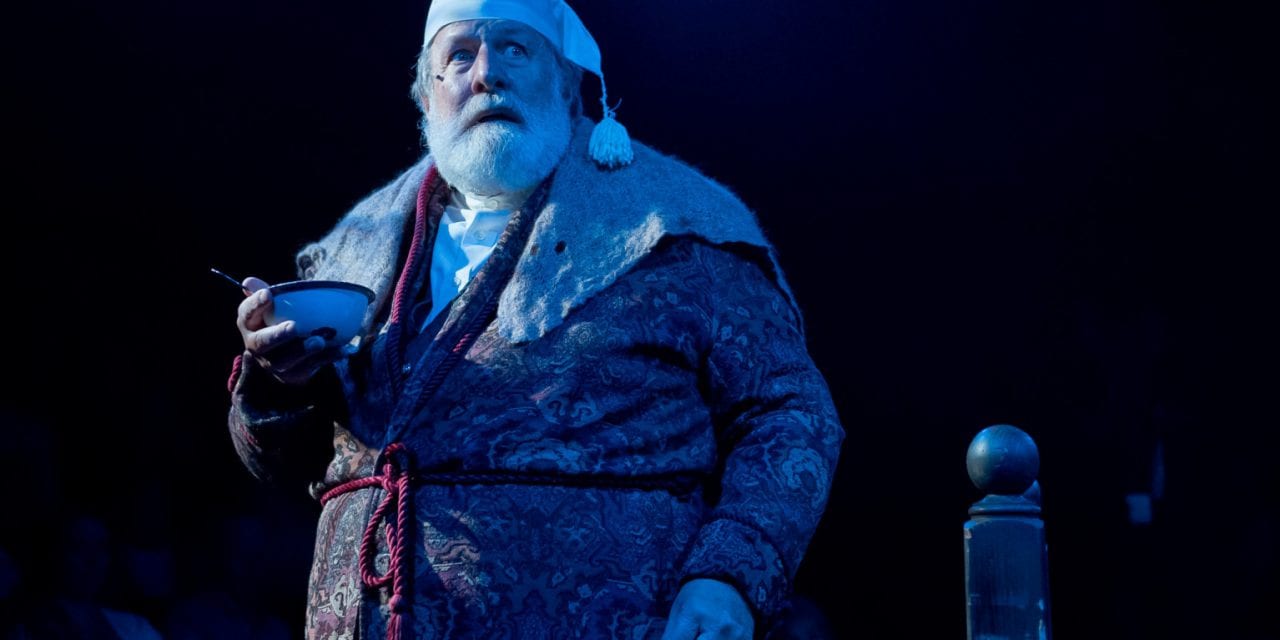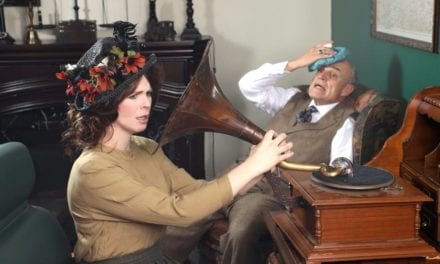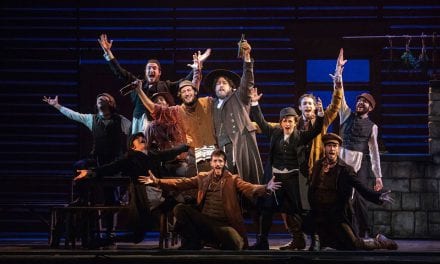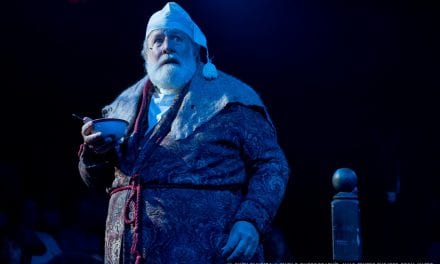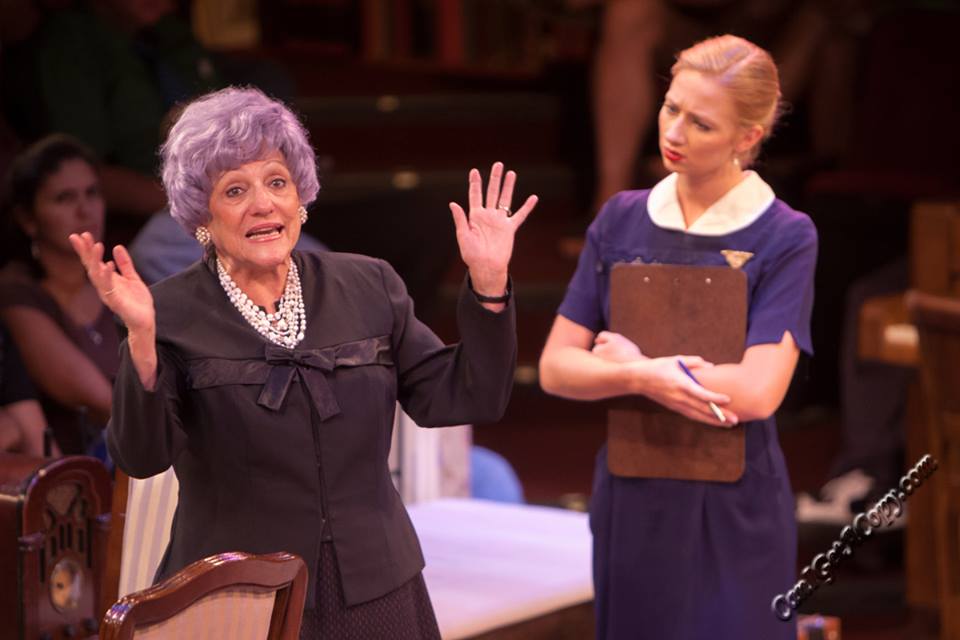OREM — Holiday traditions provide families with an anchor of stability year after year, and never have people needed stability more than during the coronavirus pandemic. The creative team and performers at Hale Center Theater Orem are filling that need with their annual production of the Charles Dickens classic A Christmas Carol. To adjust to this year’s circumstances, the show has been slimmed down and streamlined, but this modified version is an improvement that exudes the Christmas spirit.

Show closes December 23, 2020.
Director Shawnda Moss has created a lively Christmas Carol that injects vigor into the holiday favorite. The opening street scene is bustling with actors mingling with one another and recoiling from Scrooge, which provided movement that started the production energetically. Shawnda Moss kept the momentum going in key moments of the show, such as Fezziwig’s party, the boisterous arrival of the Ghost of Christmas Present, and the climactic Christmas morning scene; all of these moments brought zest to the story. The result is a show that feels alive and not like a museum piece.
This production works so well because of its strong cast. With 16 performers (just over half of last year’s cast of 30), these actors have to be versatile. Ten actors play at least three roles each, often flitting on and off stage in different costumes or wearing wigs or bonnets to distinguish their characters. But even the performers who play only one role (Chris Brower as Scrooge, a singing quartet, and a violinist) have a heavy burden. Brower is on stage for the entire play, and the musicians often enter to set the mood of a scene by singing carols or adding violin underscoring. There is something comforting in having the same faces pop up again and again on stage throughout the evening; each performer quickly becomes a familiar guide through the story. Their friendly, jovial faces never leave the stage for long, and every person’s reappearance is a welcomed sight.

David Knight as the ghost of Jacob Marley. Photo by Suzy O Photography.
Brower’s performance is reminiscent of his performance in previous years, and longtime patrons at the Orem Hale will appreciate the familiarity. But there are enough differences that add depth to his portrayal. Early in the play, Brower has Scrooge almost spit out the word “Christmas” when talking to his nephew Fred, a choice that shows the character’s disdain for the holiday season. This attitude contrasts greatly with Scrooge’s giddiness at the end of the play when he realizes that he had not missed Christmas and that he could celebrate the holiday with those around him.
Every supporting cast member deserves a full paragraph of praise, but to keep the review manageable, I must satisfy myself with a rapid survey of some of the most memorable performances. As Fred, Nick Crapo has a twinkle in his eye and an honest charm about him as the character extends the hand of friendship to his uncle. Matthew R. Carlin is an accessible Bob Cratchit; his interactions with Christie Gardiner (in the role of Mrs. Cratchit) have the believable familiarity of years of marriage behind them, especially when Bob Cratchit was insisting that Scrooge was the founder of the family’s feast. Carlin was also moving as he knelt at Tiny Tim’s grave to sing “O Come, O Come Emmanuel,” exposing the pain of a father’s grief and the hope for a deliverance from the loneliness that death had brought him. Meg Flinders is an ethereal presence as the Ghost of Christmas Past, and David Knight’s exuberant Ghost of Christmas Present is the most memorable character in the play because of his forceful voice and cheery performance.
An improvement in the production is the revised script which the producers at Hale Center Theater Orem have used this year. In my review last year, I called their usual script (by Ted Lehman) a “sometimes-clunky adaptation.” This year’s version is based on Lehman’s script (credited to “Bradley Moss with Ted Lehman and Richard Wilkins“) but is a marked improvement. The original songs have been jettisoned, and the show has been beefed up with more traditional carols, which is a non-preachy way to bring Christ into the evening more explicitly than Dickens does. One nice touch is the inclusion of a brief scene where the Ghost of Christmas Past shows Scrooge that his former fianceé, Belle (played by Ally Smoot Winters), has married and had a family of her own–a poignant display of the happiness that Scrooge denied himself.
The biggest downside with the changes to Hale Center Theater Orem’s A Christmas Carol is that the show still has an intermission. Without it, the play would clock in at 90 minutes; the break just before the visit from the Ghost of Christmas Yet to Come is the only disruption to the show’s flow. There are some other minor quibbles I have with the production. For example, the needless early voiceovers are still in the show, and the Wizard of Oz reference when the ghost of Jacob Marley (played by David Knight) visits Scrooge (“I do! I do! I do believe in spooks!”) greatly undercuts the terror of the scene and Knight’s performance. But the emphasis here should be on the word “minor.” Most audience members will let these moments pass without a second thought, and these artistic choices do not diminish the overall effectiveness of the production.
Generally, this year’s A Christmas Carol has retained the best aspects of the Orem Hale’s traditions (including Peter Terry and Dvorah Governale‘s gorgeous costume designs) and introduced improvements. The end result is a production that is spirited and effective at bringing joy to the world at the end of a difficult year.

This review was supported by a generous grant from the Orem CARE program.

